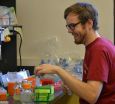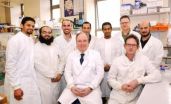(Press-News.org) When it comes to recognizing faces, humans are extraordinarily skillful. It's no surprise – after all, from the moment humans leave the womb, the infant brains already have a preference for faces, and over the course of a lifetime, the average person sees hundreds of thousands of faces.
Among scientists, however, the question of exactly how humans came to possess this amazing ability remains a divisive one, with some researchers claiming our extraordinary abilities result from the operation of mechanisms specialized just for faces, whereas others argue that recognition of any visual categories with which we acquire expertise (e.g., faces, cars, birds) depends on the same mechanisms.
Using tests conducted with patients suffering from prosopagnosia, or "face blindness," Harvard and Dartmouth researchers have taken a step toward resolving that dispute.
The study, published this week in the Proceedings of the National Academy of Sciences, showed that patients with prosopagnosia learned as well as the average person to become experts at distinguishing between highly similar exemplars of new objects. However when asked to learn a set of faces under the same conditions, the prosopagnosics did very poorly. The findings point to the idea that prosopagnosia is the result of damage to a brain mechanism specifically devoted to processing faces.
"What we wanted to do was to test a key prediction of the "expertise" hypothesis," said Constantin Rezlescu, a Post-Doctoral Fellow in Psychology and the first author of the study. "The expertise hypothesis predicts that when there is impairment in facial processing, you should also see impairment in processing other objects of expertise, because if the mechanisms are the same, any damage should affect both faces and other objects. Our findings, however, show a clear dissociation between participants' ability to recognize faces and their ability to recognize other objects with which they became experts in recognizing."
To test the expertise hypothesis, Rezlescu and colleagues recruited two patients with face blindness, and trained them to become experts in recognizing a set of 20 computer-generated objects designed to engage the brain in the way the faces do.
Called greebles, the objects can be grouped into "families" based on their body types, and each greeble shares a limited number of slightly different appendages arranged in a common configuration. To identify any single greeble, Rezlescu explained, participants must recognize those subtle differences, similar to the way humans recognize slight differences in faces.
"These are very commonly used in psychology," Rezlescu said. "One of their major uses is to investigate this expertise hypothesis…because supposedly it only takes people seven to 10 hours of training to become expert at recognizing them."
While most people can initially quickly identify greebles by family – because each has a specific body shape – to become an "expert," he explained participants must practice until they can identify individuals equally fast.
After testing patients with face blindness and a group of control test subjects on how well they recognized both faces and greebles, Rezlescu said, the results were unequivocal.
When it came to recognizing greebles, he said, patients with face blindness performed as well as the control group. Both patients, however, struggled to recognize faces, and scored far below other participants.
"What we found is that prediction – which is a fundamental prediction of the expertise hypothesis – does not hold," Rezlescu said. "That provides indirect evidence that there may be some specific mechanism for processing faces, although it doesn't prove it directly. Our conclusion is that the expertise hypothesis, at least that relying on greeble studies, is false."
Rezlescu, however, pointed out that the question of whether expertise acquired in the lab is truly equivalent to real-world expertise remains open.
"In the real world, you may have experience for 10 years or more with objects that you become an expert on," he said. "It is an open question whether the two kinds of expertise – that gained in the lab and that gained in the real world – are comparable. But it is important to note that a great deal of the evidence that was claimed to support the expertise hypothesis comes from studies involving greebles, and what we found is that cannot be true."
Going forward, Rezlescu and colleagues plan to explore predictions related to the hypothesis that the brain has specific mechanisms for recognizing faces. He also hopes to understand how the brain recognizes identity, and how information gathered from other sources – such as voices – are somehow integrated in the brain.
What's clear, he said, is that understanding faces, and the social cues they convey, are an enormously huge part of what it ultimately means to be human.
"Faces are extremely rich social stimuli" Rezlescu said. "We extract so much information from faces that we need for our day-to-day interactions. We need to be able to understand them to function."
INFORMATION: END
The fundamentals of facial recognition
Study strengthens the case for specialized brain mechanisms for recognizing faces
2014-03-25
ELSE PRESS RELEASES FROM THIS DATE:
Study finds gout drug may reduce risk of death
2014-03-25
(Boston)--In a recently to be published study in Annals of the Rheumatic Diseases, researchers have found the use of the drug allopurinol was associated with a reduced risk of death in hyperuricemic (gout) patients. The study, the first in a general population, has found the overall benefit of allopurinol on survival may outweigh the impact of rare serious adverse effects.
Researchers from the Section of Rheumatology and Clinical Epidemiology at Boston University School of Medicine (BUSM) contributed to this study.
Gout has been associated with an increased risk of ...
NOAA led study: Crude oil causes developmental abnormalities in large marine fish
2014-03-25
Crude oil from the 2010 Deepwater Horizon disaster causes severe defects in the developing hearts of bluefin and yellowfin tunas, according to a new study by a team of NOAA and academic scientists.
The findings, published in the Proceedings of the National Academy of Sciences on the 25th anniversary of the Exxon Valdez oil spill, show how the largest marine oil spill in United States history may have affected tunas and other species that spawned in oiled offshore habitats in the northern Gulf of Mexico.
Atlantic bluefin tuna, yellowfin tuna, and other large predatory ...
For neurons in the brain, identity can be used to predict location
2014-03-25
Cold Spring Harbor, NY – Throughout the world, there are many different types of people, and their identity can tell a lot about where they live. The type of job they work, the kind of car they drive, and the foods they eat can all be used to predict the country, the state, or maybe even the city a person lives in.
The brain is no different. There are many types of neurons, defined largely by the patterns of genes they use, and they "live" in numerous distinct brain regions. But researchers do not yet have a comprehensive understanding of these neuronal types and how ...
Scientists find a molecular clue to the complex mystery of auxin signaling in plants
2014-03-25
Wikipedia lists 65 adjectives that botanists use to describe the shapes of plant leaves. In English (rather than Latin) they mean the leaf is lance-shaped, spear-shaped, kidney-shaped, diamond shaped, arrow-head-shaped, egg-shaped, circular, spoon-shaped , heart-shaped, tear-drop-shaped or sickle-shaped — among other possibilities.
How does the plant "know" how to make these shapes? The answer is by controlling the distribution of a plant hormone called auxin, which determines the rate at which plant cells divide and lengthen.
But how can one molecule make so many ...
Innovative technique provides inexpensive, rapid and detailed analysis of proteins
2014-03-25
Proteins are vital participants in virtually all life processes, including growth, repair and signaling in cells; catalysis of chemical reactions and defense against infection. For these reasons, proteins can provide critical signposts of health and disease, provided they can be identified and assessed in a clinical setting.
Accurately characterizing proteins for diagnostic and therapeutic purposes has been an enormous challenge for the medical community. At the Biodesign Institute's Molecular Biomarkers Laboratory at Arizona State University, research focuses on the ...
Researchers take mathematical route to fighting viruses
2014-03-25
Mathematicians at the University of York have joined forces with experimentalists at the University of Leeds to take an important step in discovering how viruses make new copies of themselves during an infection.
The researchers have constructed a mathematical model that provides important new insights about the molecular mechanisms behind virus assembly which helps to explain the efficiency of their operation.
The discovery opens up new possibilities for the development of anti-viral therapies and could help in the treatment of a range of diseases from HIV and Hepatitis ...
A new concept for manufacturing wrinkling patterns on hard nano-film/soft-matter substrate
2014-03-25
Wrinkling is a common phenomenon for thin stiff film adhered on soft substrate. Various wrinkling phenomenon has been reported previously. Wu Dan, Yin Yajun, Xie Huimin,et al from Tsinghua University proposed a new method to control wrinkling and buckling of thin stiff film on soft substrate. It is found that the curve pattern on the soft substrate has obvious influence on the wrinkling distribution of the thin film/soft substrate. Their work, entitled "Controlling the surface buckling wrinkles by patterning the material system of hard-nano-film/soft-matter-substrate", ...
Psychiatric complications in women with PCOS often linked to menstrual irregularity
2014-03-25
(NEW YORK, NY, March 24, 2014) – Polycystic ovary syndrome (PCOS), a hormone imbalance that causes infertility, obesity, and excessive facial hair in women, can also lead to severe mental health issues including anxiety, depression, and eating disorders. A study supervised by Columbia University School of Nursing professor Nancy Reame, MSN, PhD, FAAN, and published in the Journal of Behavioral Health Services & Research, identifies the PCOS complications that may be most responsible for psychiatric problems. While weight gain and unwanted body hair can be distressing, irregular ...
Shorter sleepers are over-eaters
2014-03-25
Young children who sleep less eat more, which can lead to obesity and related health problems later in life, reports a new study by UCL researchers.
The study found that 16 month-old children who slept for less than 10 hours each day consumed on average 105kcal more per day than children who slept for more than 13 hours. This is an increase of around 10% from 982kcal to 1087kcal.
Associations between eating, weight and sleep have been reported previously in older children and adults, but the study, published in the International Journal of Obesity, is the first to directly ...
Instant immune booster dramatically improves outcome of bacterial meningitis and pneumonia
2014-03-25
AUDIO:
This is a podcast interview with Professor Schwaeble.
Click here for more information.
"I am really excited about this landmark discovery. We demonstrate that boosting the innate immune system can have a significant impact on the body's ability to defend itself against life-threatening infections" - Professor Wilhelm Schwaeble from the University of Leicester's Department of Infection, Immunity and Inflammation
IMAGES AND A PODCAST INTERVIEW WITH PROFESSOR SCHWAEBLE ...
LAST 30 PRESS RELEASES:
Making lighter work of calculating fluid and heat flow
Normalizing blood sugar can halve heart attack risk
Lowering blood sugar cuts heart attack risk in people with prediabetes
Study links genetic variants to risk of blinding eye disease in premature infants
Non-opioid ‘pain sponge’ therapy halts cartilage degeneration and relieves chronic pain
AI can pick up cultural values by mimicking how kids learn
China’s ecological redlines offer fast track to 30 x 30 global conservation goal
Invisible indoor threats: emerging household contaminants and their growing risks to human health
Adding antibody treatment to chemo boosts outcomes for children with rare cancer
Germline pathogenic variants among women without a history of breast cancer
Tanning beds triple melanoma risk, potentially causing broad DNA damage
Unique bond identified as key to viral infection speed
Indoor tanning makes youthful skin much older on a genetic level
Mouse model sheds new light on the causes and potential solutions to human GI problems linked to muscular dystrophy
The Journal of Nuclear Medicine ahead-of-print tip sheet: December 12, 2025
Smarter tools for peering into the microscopic world
Applications open for funding to conduct research in the Kinsey Institute archives
Global measure underestimates the severity of food insecurity
Child survivors of critical illness are missing out on timely follow up care
Risk-based vs annual breast cancer screening / the WISDOM randomized clinical trial
University of Toronto launches Electric Vehicle Innovation Ontario to accelerate advanced EV technologies and build Canada’s innovation advantage
Early relapse predicts poor outcomes in aggressive blood cancer
American College of Lifestyle Medicine applauds two CMS models aligned with lifestyle medicine practice and reimbursement
Clinical trial finds cannabis use not a barrier to quitting nicotine vaping
Supplemental nutrition assistance program policies and food insecurity
Switching immune cells to “night mode” could limit damage after a heart attack, study suggests
URI-based Global RIghts Project report spotlights continued troubling trends in worldwide inhumane treatment
Neutrophils are less aggressive at night, explaining why nighttime heart attacks cause less damage than daytime events
Menopausal hormone therapy may not pose breast cancer risk for women with BRCA mutations
Mobile health tool may improve quality of life for adolescent and young adult breast cancer survivors
[Press-News.org] The fundamentals of facial recognitionStudy strengthens the case for specialized brain mechanisms for recognizing faces





